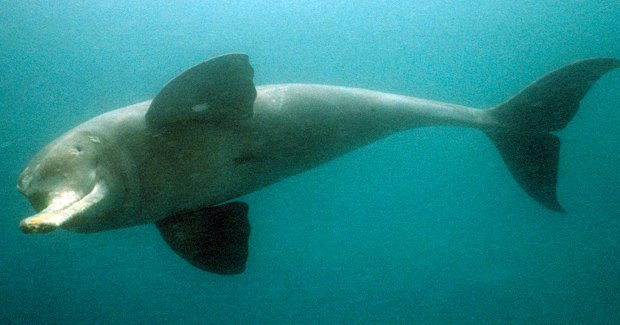Plight of the Ganges dolphin

IT IS NOT IMMEDIATELY clear what the brown hump is that appears and then disappears just a boat’s length ahead. But as the mist burns off in the weak new-year sun, we clearly see the arc of not one, but two rare Gangetic dolphins. It’s a mesmerising sight and we are privileged to see it: there are just 28 resident dolphins left in Nepal, according to a survey carried out in 2008, and only four in the Karnali River, a tributary of the Ganges, where we are.
“There used to be hundreds of them,” says Tej Kumar Shrestha, professor of zoology at Tribhuvan University in Kathmandu, who led the survey and has studied the dolphin extensively over the past 15 years. “Every time I carry out the river survey, I find there are less and less. In five years’ time, I expect the dolphin will be extinct in Nepal.”
The Gangetic dolphin (Platanista gangetica) is predominantly found in India and Bangladesh, where there are estimated to be around 3000 in the Ganges and Brahmaputra rivers. Its numbers have crashed by 50 per cent over the past decade and the aquatic mammal is on the IUCN Red List of Threatened Species.
A sub-species of the dolphin, Platanista gangetica minor, is found in the Indus River in Pakistan, where the creature has been separated from its brethren in India by dams and dried-up rivers for so long – hundreds of years – that physical differences have emerged.
The same may well be true of Nepal’s dolphin, known locally as susu. This is because the network of barrages built between the eastern Ganges – where the vast majority of the dolphins are found – and the western Ganges on the Nepalese-Indian border has separated these two populations for the past half-century, Shrestha says.
“Nobody has done the DNA studies to check whether it is a distinct sub-species,” he says. “But I see marked differences even between the ones that are permanently resident in Nepal and the ones that annually migrate across from the western Ganges in India. The migratory ones are blacker with a longer snout and a bigger body.”
Each June, during the monsoon rains, migratory dolphins of breeding age (between three and 25 years old) journey to the cooler, fast-flowing, oxygenated waters of Nepal. Here, they breed and hunt in the rejuvenated streams and oxbow lakes before returning south in September. “If they can’t migrate over, they can’t breed,” Shrestha says.
The increasing numbers of barrages and dams along the rivers prevent the dolphins’ passage in either direction unless flood levels are high enough to allow the aquatic mammals to swim through. “The government needs to ensure that every barrage has a fish ladder that is wide enough for the [more than two-metre-long] dolphins to use,” says Andrew Duncan, a wildlife management expert who is based in Bardia National Park, which encompasses a great part of the Karnali River.
Challenges
Climate change is making the problem worse. The monsoon has been arriving weeks later in recent years, and in more concentrated bursts. The floods are higher and in 2007 as many as 45 dolphins migrated across after the waters completely washed away one major barrage. But the rains are also briefer, draining the streams and pools too soon for the dolphins to return and causing more of them to become stranded, Shrestha says.
And the increasingly drier winters are leading farmers to divert more water from the rivers for crop irrigation. Dolphins that take a wrong turn end up stranded in these narrow irrigation channels when the waters recede. “The villagers then take their khukri [traditional Ghurka’s knife] and chop off its head for food,” Shrestha says.
People also hunt the dolphins (using a bow and arrows) for food and to collect their ‘fish’ oil’, he says, showing me a gruesome photograph of a dolphin suspended from a tall post by its tail with a bucket beneath it to collect the oil.
Pollution, over-fishing and deliberate poisoning of their waters add to the dolphins’ plight. “Villagers fish by emptying an entire can of pesticide into the river and collecting all the dead fish as they rise to the surface,” says Manoj Gautam, who heads Nepal’s branch of Roots and Shoots, the conservation organisation set up by Jane Goodall. The practice poisons the dolphins so they aren’t fit enough to breed, but it is regarded as entirely harmless by most villagers.
It is illegal to kill a dolphin – the penalty is 70,000 rupees (about AUD$900) or 10 years imprisonment, but the law has never been enacted. “The police are bribed,” Shrestha says. “And anyway, there’s no room in the prisons because they’re overflowing with political prisoners from the past decade’s insurgency,” he laughs.
The political insurgency battered the wildlife as well as the people. “This area was one of the worst affected by the conflict,” says Duncan, who is campaigning for better patrol facilities in the area, such as speedboats for the park wardens. “Endangered creatures from dolphin to antelope to gharial crocodiles were slaughtered by the starving people, acres of forestry were felled for firewood and timber, and there was widespread poaching of tigers and rhino.”
Everybody is hoping for peace in this troubled country, to enable the people and its animals to recover. As my boat pulls in to the jetty I realise that the susus I was lucky enough to see may turn out to be the last of Nepal’s resident dolphins.
Gaia Vince is an Australian journalist who is travelling around the world reporting on the effectsof climate change and sending regular dispatches to Australian Geographic. She writes for the BBC, New Scientist and The Guardian. Find her blog at wanderinggaia.com.

